Kalina people
The Kalina, also known as the Caribs, mainland Caribs and several other names, are an indigenous people native to the northern coastal areas of South America. Today, the Kalina live largely in villages on the rivers and coasts of Venezuela, Guyana, Suriname, French Guiana, and Brazil. They speak a Cariban language known as Carib.[3] They may be related to the Island Caribs of the Caribbean, though their languages are unrelated.
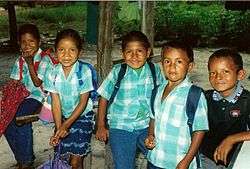 Kalina schoolchildren from Bigi Poika, Suriname, 2002. | |
| Total population | |
|---|---|
| 21,714 [1][2] | |
| Regions with significant populations | |
| 4,000–5,000[2] | |
| 2,500[2] | |
| > 475[2] | |
| 3,000[2] | |
| < 100[2] | |
| Languages | |
| Kali'na Various local languages | |
| Religion | |
| Animism, Christianity | |
| Related ethnic groups | |
| Island Caribs | |
Name
Traditionally, Westerners have called the Kalina people variants of the Spanish name Caribe, including "Caribs" in English, Galina in French, and Karaïeb in Dutch. However, the speakers call themselves Kalina or Karìna [kaɽiɁnʲauɽaŋ], spelled variously.[4] Variants include Kali'na, Cariña, Kariña, Kalihna, Kalinya; other native names include Maraworno and Marworno. Kalina may distinguish themselves as Kali'na tilewuyu ("true Kalina"), partly to differentiate themselves from the mixed Maroon-Kalina inhabitants of Suriname.[5] Use of "Kalina" and related variants has become common practice only recently in publications; many sources continue to use "Caribs" or associated names.[4]
History
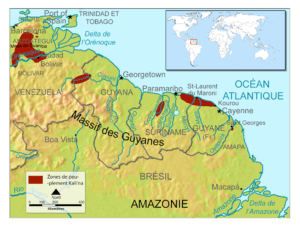
Lacking a written form of language before the arrival of Europeans, Kali'na history was passed down orally from one generation to the next through tales of myth and legend.
For a long time, the few Europeans studying the history of the Amerindian people of this area did not distinguish between the various Caribbean tribes. Once the period of exploration was over, interest in the study of these people diminished greatly and did not re-emerge until the end of the 20th century, when a few French expatriates, notably Gérard Collomb, became interested in the Kali'na, and the Kali'na themselves began to relate their history, in particular Félix Tiouka, president of the Association of Amerindians of French Guiana (AAGF), and his son Alexis.
For the reasons given, historical information regarding the Kali'na is rare and incomplete.
Pre-Columbian era
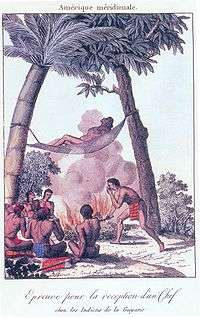
Making up for lack of written records, archaeologists have to date uncovered 273 Amerindian archeological sites on only 310 km² of the land recovered from the Sinnamary River by the Petit-Saut Dam. Some date back as far as two thousand years, establishing the antiquity of the Amerindian presence in this area.[6],[7]
The weak historical clues available indicate that before 1492, the Kali'na inhabited the coast (from the mouth of the Amazon River to that of the Orinoco), dividing their territory with the Arawak, against whom they fought during their expansion toward the east and the Amazon River.[8],[9]
They were prolific travelers even though they weren't nomads. They often traveled by land and by sea as far as the area around the Orinoco river to visit family, trade, and marry.[10] They often went to the area surrounding the Essequibo river (now in Guyana) to collect pebbles of red porphyry (takuwa), which Kali'na women prized for polishing their pottery.[11] The term takuwa also refers to jade, which was often traded in the Americas in general.[12]
Colonization
The Palanakiłi arrive
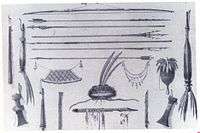
In their first contact with Europeans, the Kali'na thought they were dealing with the spirits of the sea, Palanakiłi, a name they use to this day when referring to whites.[13][14]
One of the first consequences of the arrival of Europeans, as in the case of many other Native American peoples, was a decrease in population due to violence inflicted by European soldiers genocide, and diseases brought over by the Europeans. The Kali'na quickly succumbed in large numbers, because their immune systems were not adapted to the viruses and bacteria of the Old World.
At that time, the Kali'na knew only stone axes and hardwood machetes. These men brought with them axes and machetes of iron, they showed that they cut much better ... This time, the Palanakiłi had brought good things.[15]
Amerindians in Paris
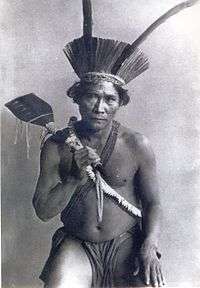
The second half of the nineteenth century saw the heyday of World's Fairs, in which European countries were displaying their wealth with colonial "villages" representing the colonized cultures. Although the World's Fairs of Paris did not have "Amerindian villages," public curiosity was such that Kali'na were sent to the capital twice - once in 1882 and again in 1892 - to be exhibited as oddities at the Jardin d'Acclimatation.[16],[17]
1882
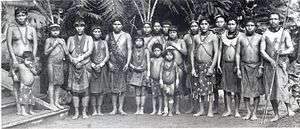
Fifteen Kali’na, all members of one family living in Sinnamary and Iracoubo, were sent to Pau:wa ("The Land of the Whites") in July 1882.[16] Almost nothing is known about them, except their names[18] and the fact that they were housed in huts on the lawn of the Jardin d'Acclimatation. The trip lasted four months, including three in Paris and a month's journey by boat (round trip). They were accompanied by a Creole who acted as intermediary and, presumably, interpreter.[19] There are several portraits of them, taken by photographer Pierre Petit.[20]
The Kali'na today
Geographic distribution
The part of South America where the Kali'na live is very sparsely populated. However, the people of this ethnic group are such an extreme minority in all of the countries in which they are well established that locally they are a majority only in certain very secluded areas. Their current geographic distribution covers only a small fraction of their Pre-Columbian territory.
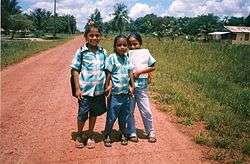
- In Brazil, they are especially localized in São José dos Galibi, a village founded in 1950 on the right bank of the Oyapock River opposite Saint-Georges in French Guiana by several families who came from the region of the Mana River. They are also in the capital of Amapá, Macapá, and in Pará, in Belém.[21]
- In French Guiana, they are still present in significant numbers in their original territory, the region between the Maroni and the Mana rivers (in particular, the communities of Awala-Yalimapo, the only one where they are a majority, Saint-Laurent-du-Maroni, Mana and Iracoubo), and the Amerindian village of Kourou as well as, in fewer numbers, the island of Cayenne.
- In Suriname, they are a strong presence on the left bank of the Maroni River and on the banks of the Coppename River.
- In Venezuela, the country where their numbers are the greatest, they can be found in two distinct zones: in the llanos of the Orinoco river valley and on the Cuyuni River valley part of which is in Guyana. See also Chimire, Venezuela.
Music
They use mostly percussion instruments. Their sanpula (or sambula) is a large drum with two skins stretched over either end of the shell by hoops pulled together with cord and is played with a mallet. They also have two kinds of maracas, called a kalawasi (or kalawashi) and a malaka.
Their flute, the kuwama, is still made but is more and more often replaced by the European flute. There is also a terra cotta horn called a kuti.
Language
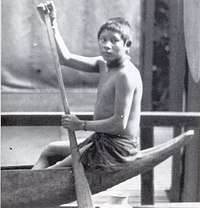
They speak Kali'na, belonging to the family of Cariban languages, is today still spoken by above 10,000 people in the coastal strip that stretches from Venezuela (5,000 speakers) to Brazil (100) passing through Guyana (475), Suriname (2,500) and French Guiana (3,000 people).
Thanks to the relatively significant number of speakers, it is one of the most likely Amazonian tongues to survive. Some experiments with written transcription were undertaken in Guyana.[22] Linguistic standardization of a Kali'na writing system however is plagued by the diversity of the many different forms of the written language currently in use, which have been influenced by the languages of the colonists of the countries in which the Kali'na live, Spanish, Portuguese, Dutch, French and English. Thus, even as far as their ethnonym is concerned, Kali'na, there are no fewer than nine different writing systems. Kali'na therefore remains a primarily oral language.
See also
- Adaheli, the Sun in the mythology of the Orinoco region
- Classification of indigenous peoples of the Americas
Notes
- Population and territory of Amerindians of the Amazon. APFT Pilot Report. (retrieved 23 March 2011)
- List of Amerindian populations of the Amazon
- Courtz, Henk (2008). A Carib Grammar and Dictionary. Magoria Books. pp. 1–4. ISBN 978-0978170769. Retrieved May 22, 2014.
- Courtz, Henk (2008). A Carib Grammar and Dictionary (PDF). Magoria Books. p. 1. ISBN 978-0978170769. Retrieved May 22, 2014.
- (in Dutch and French) Wim Hoogbergen, Origins of the Suriname Kwinti Marrons; Nieuwe West-Indische Gids, vol. 66 (1 & 2), p. 27-59. 1992. For a similar case of mixed Afro-Caribbean ancestry see the article Garifuna people. Source quoted in Gérard Collomb and Félix Tiouka, Na’na Kali’na - Une histoire des Kali’na en Guyane ; Ibis Rouge Éditions, 2000 ; ISBN 2-84450-068-4, henceforth referred to as Na'na.
- (in French) Stéphane Vacher, Sylvie Jérémie, Jérôme Briand ; Amérindiens du Sinnamary (Guyane), Archéologie en forêt équatoriale ; Documents d’Archéologie française, Éditions de la Maison des Sciences de l’Homme, Paris, 1998.
- Na'na, p. 35.
- Na’na, p. 45.
- Na’na, p. 41.
- Collomb, Gérard. (2000). Na'na Kali'na : une histoire des Kali'na en Guyane. Ibis rouge. ISBN 2844500684. OCLC 937751323.
- Barrere, Pierre (1743). Nouvelle relation de la France equinoxiale, contenant la description des cotes de la Guiane. Piget etc. OCLC 880789716.
- Boomert, Arie (1987). Gifts of the Amazons: "green stones", pendants and beads as items of ceremonial exchange in Amazonia and the Caribbean. Caracas: Antropologica.
- Na’na, p. 31.
- There is also a river version of these spirits, Tunakiłi, which appeared in the form of a young woman who overturned canoes and drowned people.
- (in French) Oral history of the Kali’na, Na’na, p. 32.
- (in French) Gérard Collomb, Félix Tiouka et M.P. Jean-Louis, Pau:wa Itiosan:bola : Des Galibi à Paris en 1892, décembre 1991.
- (in French) Il y eut aussi des Kali’na et des Arawak du centre du Suriname dans l’Exposition universelle d’Amsterdam en 1883, ainsi que des Noirs Marrons Saramaca et des Créoles.
- (in French) L. Manouvrier, Sur les Galibis du Jardin d’acclimatation, Bulletin de la Société d’Anthropologie de Paris, 1882, p. 602-640. Cité dans Pau:wa.
- (in French) J. Noutous, Les Galibis du Jardin d’Acclimatation, La vie moderne, quotidien, Paris, 12 août 1882. Cité dans Pau:wa.
- (in French) Faisant partie de la Collection de la Société de Géographie de Paris, elles peuvent être consultées à la Bibliothèque nationale de France, Département Cartes et Plans.
- (in Portuguese) Galibi do Oiapoque
- (in French) *Une aventure éditoriale en Guyane française : créer, publier, diffuser des livres pour enfants. 1988-1997, Nicole Mounier.
References
- (in French) Gérard Collomb and Félix Tiouka ; Na’na Kali’na - Une histoire des Kali’na en Guyane ; Ibis Rouge Éditions, 2000 ; ISBN 978-2-84450-068-7
- (in French) Gérard Collomb, Félix Tiouka and M.P. Jean-Louis ; Pau:wa Itiosan:bola : Des Galibi à Paris en 1892 ; Awala-Yalimapo, December 1991
- (in French) Gérard Collomb ; Kaliña. Des Amérindiens à Paris. Photographies du prince Roland Bonaparte. ; Éditions Créaphis, Paris, 1992.
- (in French) Jean Hurault ; Français et indiens en Guyane. 1604-1972 ; Paris, 1972 ; Guyane Presse Diffusion, Cayenne, 1989.
- (in French) Jil Silberstein ; Kali’na : Une famille indienne de Guyane française ; Albin Michel, 2002 ; ISBN 2-226-13300-3
- (in French) Serge Mam Lam Fouck ; Histoire générale de la Guyane française, Cayenne, Ibis Rouge Éditions, 1996; ISBN 978-2-84450-163-9
- (in French) Other works of Gérard Collomb, researcher at CNRS and specialist in Kali'na culture.
Further reading
- Magaña, Edmundo et Jara, Fabiola. "The Carib sky". In: Journal de la Société des Américanistes. Tome 68, 1982. pp. 105-132. [DOI: https://doi.org/10.3406/jsa.1982.2212] www.persee.fr/doc/jsa_0037-9174_1982_num_68_1_2212